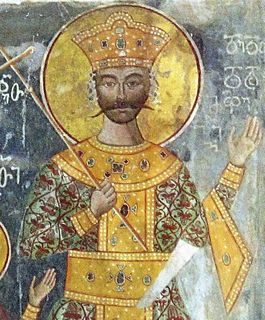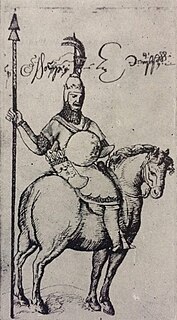
George II, of the Bagrationi Dynasty, was a king of Imereti from 1565 to 1585.

Alexander III, of the Bagrationi Dynasty, was a king of Imereti from 1639 to 1660.
Bagrat V (1620–1681), of the Bagrationi Dynasty, was a king of Imereti, whose troubled reign in the years of 1660–61, 1663–68, 1669–78, and 1679–81, was marked by extreme instability and feudal anarchy in the kingdom.
Giorgi III Gurieli, of the Georgian House of Gurieli, was Prince of Guria from 1669 to 1684 and King of Imereti from 1681 to 1683. He was energetically involved in civil wars in western Georgian polities, which he sought to bring under his sway. He was killed in battle while trying to recover the lost throne of Imereti.

Mamia III Gurieli, also known as Mamia the Great Gurieli or the Black Gurieli, of the western Georgian House of Gurieli, was Prince of Guria from 1689 to 1714. Involved in civil wars plaguing western Georgia, he became King of Imereti three times in the years of 1701, 1711–1712, and 1713–1714. After his first reign as king for a year in 1701, he abdicated the throne of Imereti, being unable to tolerate the influence of his father-in-law Giorgi Abashidze. Subsequent periods of his royal career was the result of a feud with Giorgi VII of Imereti. Mamia died while still sitting on the throne of Imereti, which then reverted to his rival Giorgi VII.
Alexander V of Imereti, of the Bagrationi Dynasty, was King of Imereti from 1720 his death in 1752, with the exceptions of the periods of 1741 and 1746–1749.
Tamar was a Georgian princess of the House of Mukhrani who was married, successively, to three sovereigns of western Georgia—Levan III Dadiani, Prince of Mingrelia, then King Bagrat V of Imereti, and finally, Giorgi III Gurieli, Prince of Guria. Tamar's marriages were part of political intrigues and accompanying wife swaps characteristic for the Georgian history of that century.
Vakhtang was a Georgian prince of the Bagrationi dynasty of the Kingdom of Imereti, a younger son of King Alexander II of Imereti by his wife Tamar.

Levan I Dadiani was a member of the House of Dadiani and ruler of Odishi, that is, Mingrelia, in western Georgia. He succeeded on the death of his father, Mamia III Dadiani, as eristavi ("duke") of Odishi and ex officio mandaturt-ukhutsesi of Imereti in 1533. Dadiani's break with the king of Imereti brought about his downfall and imprisonment in 1546. He was able to escape and regain his possessions, securing Ottoman support for his independence from Imereti.
Giorgi III Dadiani was Prince of Mingrelia, of the House of Dadiani, from 1572 to 1573 and again from 1578 until his death. He was a son and successor of Levan I Dadiani.
Mamia IV Dadiani was Prince of Mingrelia, of the House of Dadiani, from 1573 to 1578 and again from 1582 until his death. He was a younger son of Levan I Dadiani.

Manuchar I Dadiani was Prince of Mingrelia, of the House of Dadiani, from 1590 until his death. A younger son of Levan I Dadiani, he succeeded on the death of his elder brother, Mamia IV Dadiani.

Giorgi IV Dadiani was Prince of Mingrelia from 1691 to 1704 and from 1710 to 1715. Giorgi's accession to rulership, following his ouster of the First House of Dadiani, inaugurated Mingrelia's second Dadiani dynasty, stemming from the Chikovani clan. Giorgi was also known as Lipartiani (ლიპარტიანი) by virtue of having Salipartiano as a fief from 1682 to 1715. Giorgi was actively involved in a series of civil wars that plagued the western Georgian polities. He was eventually deposed by his own son and placed under house arrest.
Mamia I Gurieli, of the House of Gurieli, was Prince of Guria from 1512 until his death in 1534. Succeeding on the death of his father Giorgi I Gurieli, Mamia became involved in the conflict between the two eastern Georgian kingdoms of Kartli and Kakheti in 1520; by force of arms, he compelled David X of Kartli to agree on peace with Levan of Kakheti, his son-in-law. Mamia Gurieli's 1533 campaign, jointly with his namesake Prince of Mingrelia, against the homebase of Circassian pirates ended in a fiasco, with Mamia being captured and ransomed later that year.
Rostom Gurieli, of the House of Gurieli, was Prince of Guria from 1534 until his death in 1564. Alongside his royal suzerain, Bagrat III of Imereti, Rostom fought against the expanding Ottoman Empire to which he lost parts of his principality. Rostom's relations with Bagrat III subsequently deteriorated over his support to the king's defiant vassal, Levan I Dadiani.
Giorgi II Gurieli, of the House of Gurieli, was Prince of Guria from 1564 to 1583 and again from 1587 to 1600. Succeeding on the death of his father Rostom Gurieli, Giorgi's rule over his small principality, located in southwest Georgia, was a period of conflict with the neighboring Dadiani of Mingrelia and increasing assertiveness of the Ottomans whom Gurieli submitted in 1581. His reign was interrupted, from 1583 to 1587, by a Mingrelian invasion, but Giorgi was able to resume the throne with Ottoman support.
Mamia II Gurieli, of the House of Gurieli, was Prince of Guria from 1600 until his death at the hands of his own son Simon in 1625. Mamia's rule over his small principality, located in southwest Georgia, saw efforts to rebuff encroachments of the Ottoman Empire, with which he was forced to make peace in 1614, conceding the loss of territories and placing Guria under the obligation of paying tribute.
Kaikhosro I Gurieli, of the House of Gurieli, was Prince of Guria from 1626 to 1658. He was installed by Levan II Dadiani, Prince of Mingrelia, in place of his deposed predecessor Simon I Gurieli. In his turn, Kaikhosro was overthrown and expelled by King Alexander III of Imereti. His comeback to Guria, in an Ottoman-supported endeavor, concluded with his assassination by a Gurian nobleman.













